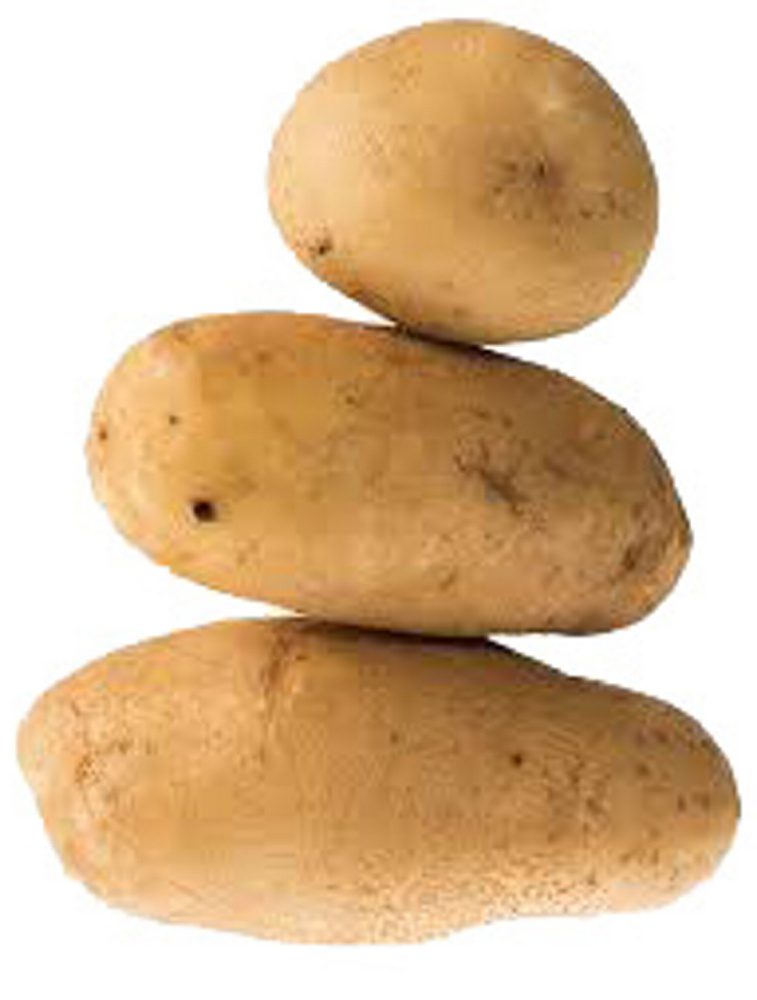Potatoes are Maine’s top-grossing agricultural crop, so it makes sense that the University of Maine – the state’s flagship Land Grant university – would be involved in potato research and development.
Still, I was surprised last winter when I saw Caribou Russet and Pinto Gold, two new potato varieties developed at the University of Maine, offered in several garden catalogs.
Greg Porter, who has been in charge of the university’s potato breeding and variety development program since 2007 and did potato research at Orono for a couple of decades longer than that, said the two new varieties are aimed at different segments of the potato market.
Caribou Russet is a main-crop potato, good for baking, boiling and – perhaps most important – french fry production. Pinto Gold is a gourmet/specialty potato intended to reach a niche market.
They appeared in catalogs available to home gardeners because of the relationship the breeding program has developed over the years with small farms that grow seed potatoes and with Johnny’s Selected Seeds, the seed company based in Winslow, Porter said.
“We’ve been able to introduce these to both organic growers and standard growers,” he said. “It has been kind of a nice small-scale success story.”
The university staff conducts tests of potential introductions that cover taste, disease-resistance, yield and more. Johnny’s saw promise in the two latest introductions and conducted additional tests of its own, Porter said.
I had wondered if cross-breeding potatoes would be more difficult than most vegetables because growers use tubers rather than seed when they plant the crop. But getting new potato plants is easy, done just the way it is done with other vegetables.
Potato plants produce blossoms that, once they are pollinated, produce a fruit that looks like a small, shriveled-up tomato. Inside that fruit are the true seeds that, when extracted and planted, produce a potato plant.
“It is the cross-pollination that creates a plant with new characteristics, something different,” Porter said.
The staff then looks at the thousands of seedlings that are produced, selects a few with characteristics that could be desirable in the marketplace and does more tests – over a long period of time. It took 12 years of testing before Caribou Russet hit the catalogs.
“We wish there were a perfect plant out there,” Porter said, “but it is a case of balancing the improved, marketable characteristics of a plant against the negatives.”
Caribou Russet has a lot of positives. It is a tasty fresh-market potato that is good for baking and boiling. It also is a good French-fry potato, although it won’t last as well in storage as Russet Burbank.
Pinto Gold is a beautiful, unusual, almost fingerling type of potato that has great flavor, yellowish flesh, and red skin with patches of yellow. Stewart thinks it looks like a large pinto bean, which is why he gave it the name Pinto Gold.
The UMaine breeding program also produced two new potato varieties in 2014. Although I didn’t see them in any of the catalogs I get, professional farmers have been using them.
Easton, named for a small Aroostook County town, has positive characteristics as a tasty French-fry potato but has hit what Porter called “bumps in the road” in susceptibility to disease.
Sebec, named after the lake near Dover-Foxcroft, is a round white potato with many advantages over Atlantic, a common variety used in making potato chips.
Porter was raised on a Washburn potato farm that is still in his family; he got both his bachelor’s and master’s degrees at UMaine before getting his doctorate at Penn State. No wonder he likes to name his potatoes after Maine locations.
No new varieties are expected to come to market next year, he said, but depending on how testing goes, there could be some a few years from now.
Porter noted that because his department’s purpose is research, the university does not have to make money on the potato varieties it releases. That said, it does profit on some of them, which helps offset the program costs.
Potatoes can be sent to market in three ways: If released under the Plant Variety Protection Act, growers pay the university to grow the potatoes. Trademarking is more restrictive and is reserved for the more unusual plants. The university is weighing whether to trademark Pinto Gold, Porter said. If the plants are publicly released, which was the norm until about 20 years ago, no fees are paid, he said.
Porter said main-crop potatoes – high-yield, inexpensive, ordinary-looking potatoes – are the most profitable overall, because people use so many more of them. Pound for pound, however, specialty potatoes – which have a lower yield, cost more, and are especially pretty – bring growers the most money. (Varieties like the yellow-fleshed Yukon Gold bridge the gap between the two.)
For the home gardener, specialty potatoes also are more fun – which is the real reason I grow anything.
Tom Atwell has been writing the Maine Gardener column since 2004. He writes and gardens in Cape Elizabeth and can be contacted at 767-2297 or at tomatwell@me.com.
Send questions/comments to the editors.



Success. Please wait for the page to reload. If the page does not reload within 5 seconds, please refresh the page.
Enter your email and password to access comments.
Hi, to comment on stories you must . This profile is in addition to your subscription and website login.
Already have a commenting profile? .
Invalid username/password.
Please check your email to confirm and complete your registration.
Only subscribers are eligible to post comments. Please subscribe or login first for digital access. Here’s why.
Use the form below to reset your password. When you've submitted your account email, we will send an email with a reset code.